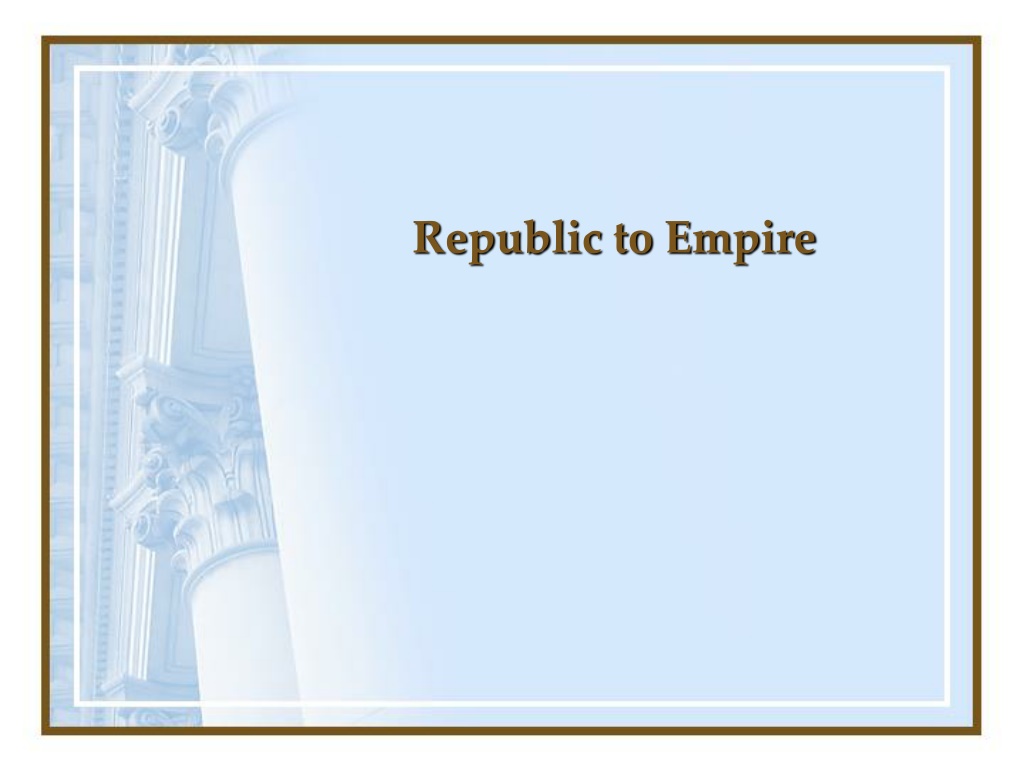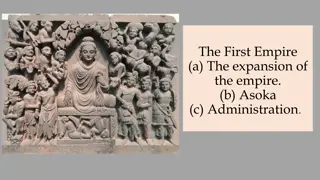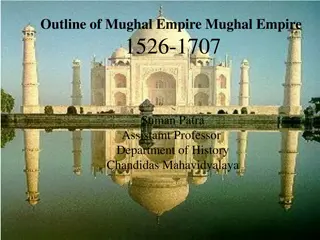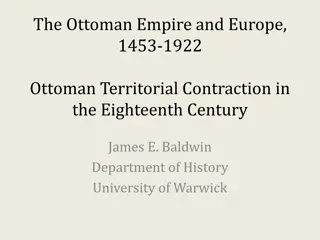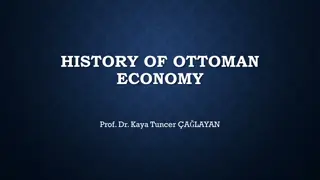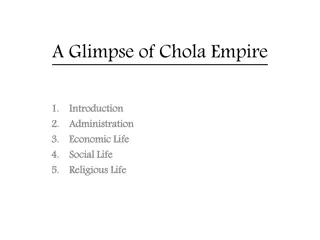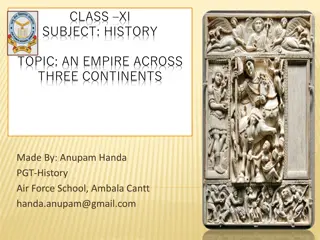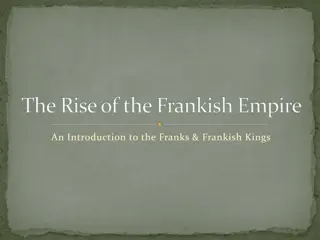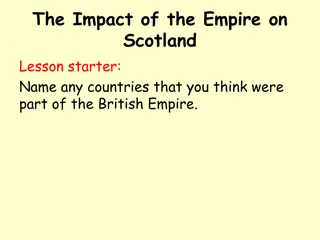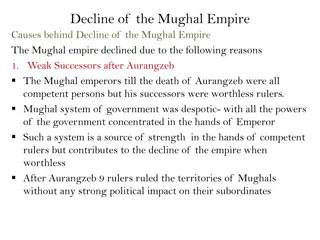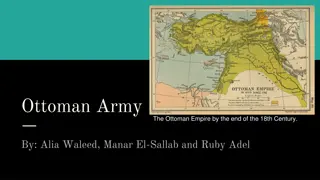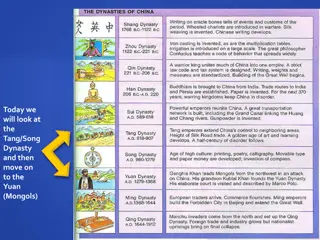Republic to Empire
Transition from Republic to Empire with successful strategies, Roman legal developments, and the pivotal Punic Wars. Discover the practicality of Roman governance, the evolution of Roman law, and the fierce conflicts that shaped Rome's destiny.
Download Presentation

Please find below an Image/Link to download the presentation.
The content on the website is provided AS IS for your information and personal use only. It may not be sold, licensed, or shared on other websites without obtaining consent from the author.If you encounter any issues during the download, it is possible that the publisher has removed the file from their server.
You are allowed to download the files provided on this website for personal or commercial use, subject to the condition that they are used lawfully. All files are the property of their respective owners.
The content on the website is provided AS IS for your information and personal use only. It may not be sold, licensed, or shared on other websites without obtaining consent from the author.
E N D
Presentation Transcript
Successful Strategies They believed they were successful because of their sense of duty, courage, and discipline. Good diplomats Extended citizenship Excelled in military matters Brilliant strategists Colonies, roads
Successful Strategies Practical Did not try to build ideal govt. Instead, created political institutions in response to problems.
Roman Law (450 B.C.) Rome s first code of laws was the Twelve Tables. Publically displayed. Protected rights for patricians and plebians. Included civil law. It proved inadequate for later Roman needs.
Roman Law The Law of Nations followed. Based on natural law, or reason. Standards of justice were created that applied to all people. Innocent until guilty The accused had a right to defend themselves Judge needed to weigh evidence
The First Punic War Phoenicians had founded Carthage around 800 B.C. With colonies from Spain to Sicily, they were the largest and richest state in the area. 264 B.C. war begins between Carthage and Rome. Punicus is the Latin word for Phoenician.
First Punic War Fought at Sicily. Romans built a large navy and won. Carthage gave up Sicily and paid a fine. Carthage added new lands in Spain to make up for loss. Rome encouraged Spaniards to revolt, which led to 2ndwar.
Second Punic War Hannibal, the greatest Carthaginian general, entered Spain and moved east with 46,000 men, horses, and 37 battle elephants. Lost elephants crossing the alps. (216 B.C.) Romans met Hannibal head-on and lost an army of 40,000 men at the Battle of Cannae.
The Second Punic War Although Hannibal remained free to roam Italy, he had neither the men nor equipment to attack major cities. Romans rebuilt troops, took back some cities, pushed Carthaginians out of Spain, and invaded Carthage rather than fight Hannibal in Italy.
Second Punic War Carthaginians recalled Hannibal. (202 B.C.) Battle of Zama Romans led by Scipio Africanus, crushed Hannibal s forces, ending the war. Spain became a Roman province
More Conquests (146 B.C) Carthage was destroyed in the Third Punic War. Romans burned city for ten days. Inhabitants were sold into slavery. Territory became a province called Africa. Also took Macedonia, Greece, and Pergamum
Hannibal the Child Soldier Hannibal's War Elephants The Death of Hannibal
Growing Unrest The backbone of Rome had been the small farmers. However, aristocrats kept taking land from them by buying them out and developing large estates Used slave labor A new large class of the landless poor drifted to the cities.
Growing Unrest Tiberius and Gaius Gracchus Brothers that urged the council of the plebs to pass land-reform bills. Senators, who were large landowners, had them killed. Instability in the govt.
A New Role for the Army (107 B.C.) General Marius began to recruit armies differently. Used volunteers from the urban and rural poor who owned no property. He promised them land and they swore an oath to him, not to the Roman state. Army was no longer under state control.
A New Role for the Army Generals were forced to get into politics to provide land they needed for veterans. General Lucius Cornelius Sulla followed suit with his new army. Senate gave him command of Asia Minor. Council of Plebs wanted Marius there instead.
A New Role for the Army (82 B.C.) Civil war broke out and Sulla seized Rome, wiping out all opposition. Restored power to the Senate. He set the example of using an army to seize power.
The First Triumvirate (82-31 B.C.) Civil wars. Crassus, Pompey, and Julius Caesar emerge as victors. They joined together to form a triumvirate a government by three people with equal power. Crassus got killed in battle. Senators didn t want Caesar to rule so they backed Pompey
The First Triumvirate They voted for Caesar to lay down his command. He refused and led his army across the Rubicon, the river that formed the southern border of his province. The phrase Crossing the Rubicon means to take a decisive action that cannot be taken back.
The First Triumvirate Pompey s army gets defeated by Caesar s. He had complete control. (45 B.C.) He was made dictator, or absolute ruler. Usually only a temporary position
Caesars reforms Gave land to the poor Weakened the Senate Increased size to 900 members Filled positions with his supporters Introduced solar calendar Many Senators thought he had plans to continue as dictator Assassinated
The Second Triumvirate Octavian, Antony, and Lepidus formed second triumvirate. Divided the Roman world Octavian took east Antony took west Lepidus lost his power Too small for two masters Antony allied himself with the Egyptian Queen Cleopatra VII
The Second Triumvirate (31 B.C.) Battle of Actium in Greece. Octavian s forces smashed their army and navy Antony and Cleopatra fled to Egypt and committed suicide Antony by sword Cleopatra by poisonous snakes
The Age of Augustus Senate awarded Octavian the title of Augustus the revered one. They also gave him the title imperator, or commander in chief English word emperor is derived from this He had a large army 28 legions of 151,000 men
The Age of Augustus He claimed to restore the republic (though he really became the first emperor). he began a new system for governing provinces Senate no longer appointed governors to provinces Now he appointed deputies instead
The Age of Augustus His attempt to conquer Germany failed General Varus troops were massacred by Germans Rome s power was not unlimited.
Later Emperors Augustus s new political system allowed the emperor to select his successor from his family. Tiberius, Caligula, Claudius, and Nero followed Augustus. They took power from Senate and became more corrupt This leads to civil war where the Roman legions revolted.
Pax Romana Five so-called good emperors followed Nerva, Trajan, Hadrian, Antonius Pius, and Marcus Aurelius (27 B.C.- 180 A.D.) They ruled during a 200 year period of peace and prosperity called the Pax Romana the Roman Peace. They adopted capable men as their sons to be their successors
New Social Programs Built aqueducts, bridges, roads and harbor facilities Provided state funds to assist poor parents in the raising and educating of their children Roman aqueduct in Spain
